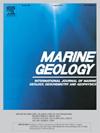海底航道形状控制混合浊度流-轮廓流
IF 2.2
3区 地球科学
Q2 GEOSCIENCES, MULTIDISCIPLINARY
引用次数: 0
摘要
浑浊流将沉积物、有机碳、营养物质和污染物从大陆架运送到深海。它们可以通过海底峡谷和水道流动数百公里。沿着它们的轨迹,这些流可能与等高流相互作用,形成混合浊积岩-等高岩沉积体系。海洋中这种系统的例子表现出各种各样的渠道形状,通常是不对称的。河道形状对浊度流的影响及其与等高线流的相互作用尚不清楚,但了解这一点可以将流动特征与海底形态联系起来。为此,纯重力驱动的流动(浊度流)和混合流动在五种不同的通道形状(三种对称和两种不对称)中进行了模拟。实验结果表明:首先,与纯重力驱动实验相比,组合流动的垂直速度梯度较小;等高线流将浊流的动量从河道外平流到上岸,降低了河道下坡的流速。其次,即使没有等值流,通道不对称也会导致不对称溢流。具体来说,在陡峭的河道边缘上,溢流比在平缓的河道边缘上更厚、更快。最后,形成了两种类型的二次流池。被限制在通道内的通道胞体和在联合流动中靠近固定锋面形成的锋面胞体。这些发现表明,仅凭沟道不对称并不能推断古轮廓水流方向。然而,当只有水深数据可用时,通道不对称可以帮助推断通道内的速度分布。本文章由计算机程序翻译,如有差异,请以英文原文为准。
Submarine channel shape controls combined turbidity current–contour current flow
Turbidity currents transport sediment, organic carbon, nutrients, and pollutants from the continental shelf to the deep sea. They can flow over hundreds of kilometers through submarine canyons and channels. Along their trajectory, these flows may interact with contour currents, creating a mixed turbidite–contourite depositional system. Examples of such systems in the oceans exhibit a variety of channel shapes that are often asymmetrical. The effect of channel shape on turbidity currents and their interaction with contour currents remains unclear, yet understanding this could link flow characteristics to seafloor morphology. To this end, purely gravity-driven flows (turbidity currents) and combined flows were simulated in five different channel shapes (three symmetrical and two asymmetrical). The experiments show that firstly, combined flows have less steep vertical velocity gradients than purely gravity-driven experiments. The contour current advects momentum of the turbidity currents out of the channel onto the overbank, reducing the downslope flow velocity in the channel. Secondly, channel asymmetry results in asymmetrically overspilling flows, even without a contour current. Specifically, the overspilling flow is thicker and faster over the steep channel margin than over the gentle margin. Lastly, two types of secondary flow cells were formed. Channel cells, which are confined to the channel, and front cells, which form near stationary fronts in combined flows. These findings suggest that channel asymmetry alone is not diagnostic for inferring paleo-contour current directions. However, channel asymmetry can help to infer velocity distributions inside channels when only bathymetric data is available.
求助全文
通过发布文献求助,成功后即可免费获取论文全文。
去求助
来源期刊

Marine Geology
地学-地球科学综合
CiteScore
6.10
自引率
6.90%
发文量
175
审稿时长
21.9 weeks
期刊介绍:
Marine Geology is the premier international journal on marine geological processes in the broadest sense. We seek papers that are comprehensive, interdisciplinary and synthetic that will be lasting contributions to the field. Although most papers are based on regional studies, they must demonstrate new findings of international significance. We accept papers on subjects as diverse as seafloor hydrothermal systems, beach dynamics, early diagenesis, microbiological studies in sediments, palaeoclimate studies and geophysical studies of the seabed. We encourage papers that address emerging new fields, for example the influence of anthropogenic processes on coastal/marine geology and coastal/marine geoarchaeology. We insist that the papers are concerned with the marine realm and that they deal with geology: with rocks, sediments, and physical and chemical processes affecting them. Papers should address scientific hypotheses: highly descriptive data compilations or papers that deal only with marine management and risk assessment should be submitted to other journals. Papers on laboratory or modelling studies must demonstrate direct relevance to marine processes or deposits. The primary criteria for acceptance of papers is that the science is of high quality, novel, significant, and of broad international interest.
 求助内容:
求助内容: 应助结果提醒方式:
应助结果提醒方式:


